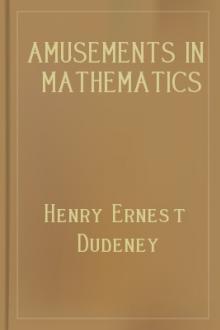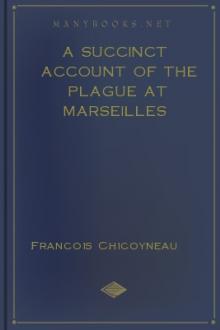Amusements in Mathematics, Henry Ernest Dudeney [books to read to be successful txt] 📗

- Author: Henry Ernest Dudeney
- Performer: 0486204731
Book online «Amusements in Mathematics, Henry Ernest Dudeney [books to read to be successful txt] 📗». Author Henry Ernest Dudeney

207.—CHERRIES AND PLUMS.—solution
There are several ways in which this problem might be solved were it not for the condition that as few cherries and plums as possible shall be planted on the north and east sides of the orchard. The best possible arrangement is that shown in the diagram, where the cherries, plums, and apples are indicated respectively by the letters C, P, and A. The dotted lines connect the cherries, and the other lines the plums. It will be seen that the ten cherry trees and the ten plum trees are so planted that each fruit forms five lines with four trees of its kind in line. This is the only arrangement that allows of so few as two cherries or plums being planted on the north and east outside rows.

208.—A PLANTATION PUZZLE.—solution
The illustration shows the ten trees that must be left to form five rows with four trees in every row. The dots represent the positions of the trees that have been cut down.

209.—THE TWENTY-ONE TREES.—solution
I give two pleasing arrangements of the trees. In each case there are twelve straight rows with five trees in every row.


210.—THE TEN COINS.—solution
The answer is that there are just 2,400 different ways. Any three coins may be taken from one side to combine with one coin taken from the other side. I give four examples on this and the next page. We may thus select three from the top in ten ways and one from the bottom in five ways, making fifty. But we may also select three from the bottom and one from the top in fifty ways. We may thus select the four coins in one hundred ways, and the four removed may be arranged by permutation in twenty-four ways. Thus there are 24 × 100 = 2,400 different solutions.

As all the points and lines puzzles that I have given so far, excepting the last, are variations of the case of ten points arranged to form five lines of four, it will be well to consider this particular case generally. There are six fundamental solutions, and no more, as shown in the six diagrams. These, for the sake of convenience, I named some years ago the Star, the Dart, the Compasses, the Funnel, the Scissors, and the Nail. (See next page.) Readers will understand that any one of these forms may be distorted in an infinite number of different ways without destroying its real character.
In "The King and the Castles" we have the Star, and its solution gives the Compasses. In the "Cherries and Plums" solution we find that the Cherries represent the Funnel and the Plums the Dart. The solution of the "Plantation Puzzle" is an example of the Dart distorted. Any solution to the "Ten Coins" will represent the Scissors. Thus examples of all have been given except the Nail.

On a reduced chessboard, 7 by 7, we may place the ten pawns in just three different ways, but they must all represent the Dart. The "Plantation" shows one way, the Plums show a second way, and the reader may like to find the third way for himself. On an ordinary chessboard, 8 by 8, we can also get in a beautiful example of the Funnel—symmetrical in relation to the diagonal of the board. The smallest board that will take a Star is one 9 by 7. The Nail requires a board 11 by 7, the Scissors 11 by 9, and the Compasses 17 by 12. At least these are the best results recorded in my note-book. They may be beaten, but I do not think so. If you divide a chessboard into two parts by a diagonal zigzag line, so that the larger part contains 36 squares and the smaller part 28 squares, you can place three separate schemes on the larger part and one on the smaller part (all Darts) without their conflicting—that is, they occupy forty different squares. They can be placed in other ways without a division of the board. The smallest square board that will contain six different schemes (not fundamentally different), without any line of one scheme crossing the line of another, is 14 by 14; and the smallest board that will contain one scheme entirely enclosed within the lines of a second scheme, without any of the lines of the one, when drawn from point to point, crossing a line of the other, is 14 by 12.

211.—THE TWELVE MINCE-PIES.—solution
If you ignore the four black pies in our illustration, the remaining twelve are in their original positions. Now remove the four detached pies to the places occupied by the black ones, and you will have your seven straight rows of four, as shown by the dotted lines.

212.—THE BURMESE PLANTATION.—solution
The arrangement on the next page is the most symmetrical answer that can probably be found for twenty-one rows, which is, I believe, the greatest number of rows possible. There are several ways of doing it.

213.—TURKS AND RUSSIANS.—solution
The main point is to discover the smallest possible number of Russians that there could have been. As the enemy opened fire from all directions, it is clearly necessary to find what is the smallest number of heads that could form sixteen lines with three heads in every line. Note that I say sixteen, and not thirty-two, because every line taken by a bullet may be also taken by another bullet fired in exactly the opposite direction. Now, as few as eleven points, or heads, may be arranged to form the required sixteen lines of three, but the discovery of this arrangement is a hard nut. The diagram at the foot of this page will show exactly how the thing is to be done.

If, therefore, eleven Russians were in the positions shown by the stars, and the thirty-two Turks in the positions indicated by the black dots, it will be seen, by the lines shown, that each Turk may fire exactly over the heads of three Russians. But as each bullet kills a man, it is essential that every Turk shall shoot one of his comrades and be shot by him in turn; otherwise we should have to provide extra Russians to be shot, which would be destructive of the correct solution of our problem. As the firing was simultaneous, this point presents no difficulties. The answer we thus see is that there were at least eleven Russians amongst whom there was no casualty, and that all the thirty-two Turks were shot by one another. It was not stated whether the Russians fired any shots, but it will be evident that even if they did their firing could not have been effective: for if one of their bullets killed a Turk, then we have immediately to provide another man for one of the Turkish bullets to kill; and as the Turks were known to be thirty-two in number, this would necessitate our introducing another Russian soldier and, of course, destroying the solution. I repeat that the difficulty of the puzzle consists in finding how to arrange eleven points so that they shall form sixteen lines of three. I am told that the possibility of doing this was first discovered by the Rev. Mr. Wilkinson some twenty years ago.
214.—THE SIX FROGS.—solution
Move the frogs in the following order: 2, 4, 6, 5, 3, 1 (repeat these moves in the same order twice more), 2, 4, 6. This is a solution in twenty-one moves—the fewest possible.
If n, the number of frogs, be even, we require (n²+n)/2 moves, of which (n²-n)/2 will be leaps and n simple moves. If n be odd, we shall need ((n²+3n)/2)-4 moves, of which (n²-n)/2 will be leaps and 2n-4 simple moves.
In the even cases write, for the moves, all the even numbers in ascending order and the odd numbers in descending order. This series must be repeated ½n times and followed by the even numbers in ascending order once only. Thus the solution for 14 frogs will be (2, 4, 6, 8, 10, 12, 14, 13, 11, 9, 7, 5, 3, 1) repeated 7 times and followed by 2, 4, 6, 8, 10, 12, 14 = 105 moves.
In the odd cases, write the even numbers in ascending order and the odd numbers in descending order, repeat this series ½(n-1) times, follow with the even numbers in ascending order (omitting n-1), the odd numbers in descending order (omitting 1), and conclude with all the numbers (odd and even) in their natural order (omitting 1 and n). Thus for 11 frogs: (2, 4, 6, 8, 10, 11, 9, 7, 5, 3, 1) repeated 5 times, 2, 4, 6, 8, 11, 9, 7, 5, 3, and 2, 3, 4, 5, 6, 7, 8, 9, 10 = 73 moves.
This complete general solution is published here for the first time.
215.—THE GRASSHOPPER PUZZLE.—solution
Move the counters in the following order. The moves in brackets are to be made four times in succession. 12, 1, 3, 2, 12, 11, 1, 3, 2 (5, 7, 9, 10, 8, 6, 4), 3, 2, 12, 11, 2, 1, 2. The grasshoppers will then be reversed in forty-four moves.
The general solution of this problem is very difficult. Of course it can always be solved by the method given in the solution of the last puzzle, if we have no desire to use the fewest possible moves. But to employ a full economy of moves we have two main points to consider. There are always what I call a lower movement (L) and an upper movement (U). L consists in exchanging certain of the highest numbers, such as 12, 11, 10 in our "Grasshopper Puzzle," with certain of the lower numbers, 1, 2, 3; the former moving in a clockwise direction, the latter in a non-clockwise direction. U consists in reversing the intermediate counters. In the above solution for 12, it will be seen that 12, 11, and 1, 2, 3 are engaged in the L movement, and 4, 5, 6, 7, 8, 9, 10 in the U movement. The L movement needs 16 moves and U 28, making together 44. We might also involve 10 in the L movement, which would result in L 23, U 21, making also together 44 moves. These I call the first and second methods. But any other scheme will entail an increase of moves. You always get these two methods (of equal economy) for odd or even counters, but the point is to determine just how many to involve in L and how many in U. Here is the solution in table form. But first note, in giving values to n, that 2, 3, and 4 counters are special cases, requiring respectively 3, 3, and 6 moves, and that 5 and 6 counters do not give a minimum solution by the second method—only by the first.
FIRST METHOD.of
Counters. L MOVEMENT. U





Comments (0)